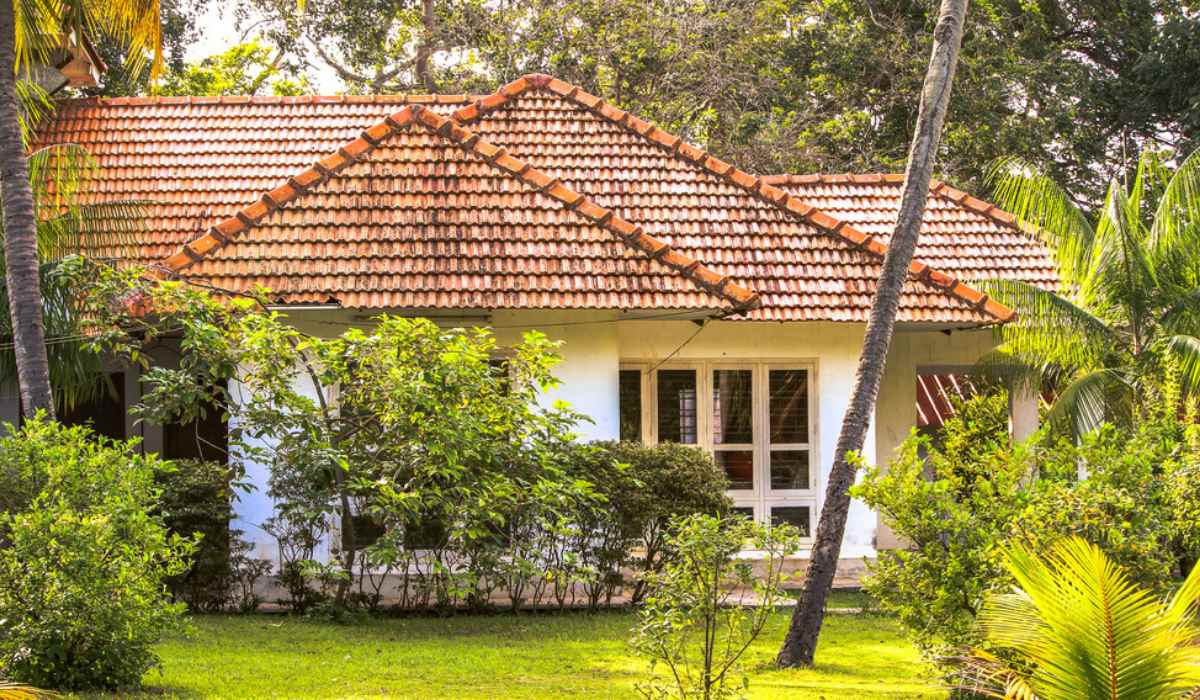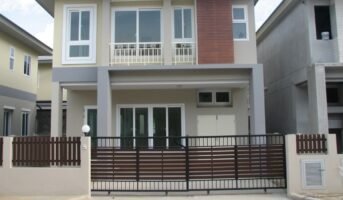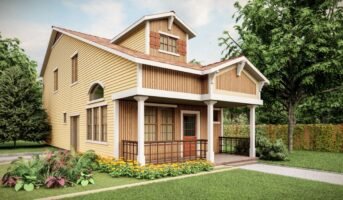Traditional houses of Kerala are still relevant. People have preserved their homes and the concepts of vernacular architectural designs. The land surrounding the houses has ample growth of fruits, vegetables and coconut trees. Houses are constructed as per Vaastu Shastra, which suggests the east and north direction for the entry of a house. Besides aesthetics and comfort, the houses are planned to deal with climatic conditions. Kerala’s traditional houses are built to withstand heavy rain and heat. The traditional architecture of Kerala is known for its use of natural materials and comfortable, well-ventilated interiors. Granaries, cattle sheds, kitchens, dining halls, bathrooms, bedrooms, puja rooms, and a well or pond are part of a well-designed traditional house called nalukettu.
To build traditional cool looking building like this, you have to get building permit in kerala using sanketham building permit portal

know about: Traditional indian houses
Kerala house design: Features
Kerala house design is known for its unique architectural style that showcases a harmonious blend of traditional and contemporary elements. Here are some key elements that define the essence of Kerala house design:
Sloping roof
One of the most distinctive features of a Kerala house is its sloping roof, also known as the “Nadumuttam” roof. The roof is typically made of clay tiles or thatched palm leaves and has a steep slope that allows rainwater to easily drain off during the monsoon season.
Wooden architecture
Wood plays a prominent role in Kerala house design, adding warmth and charm to the overall aesthetics. Intricate wooden carvings, known as “Aranmula Kannadi,” can be found on doors, windows, and pillars, showcasing the rich craftsmanship of the region.
Verandas and courtyards
Kerala houses often feature spacious verandas and courtyards that serve as gathering spaces for family and friends. These open areas provide ample natural light and ventilation while creating a seamless connection between the indoors and outdoors.
Ventilation and cross ventilation
Kerala’s tropical climate calls for effective ventilation systems in house design. Traditional Kerala houses are designed to allow cross ventilation, with windows strategically placed to capture the cool breeze and maintain a comfortable indoor environment.
Poomukham
Poomukham is the entrance area of a Kerala house, usually adorned with intricate woodwork and decorative elements. It serves as a welcoming space and is often decorated with floral arrangements, traditional lamps, and religious symbols.
Open floor plans
Kerala houses typically feature open floor plans that promote a sense of spaciousness and allow for better airflow. The layout is designed to facilitate a smooth flow between rooms, emphasising a sense of togetherness and communal living.
Natural materials
Kerala house design embraces the use of natural materials such as wood, stone, and clay, creating a strong connection to the local environment. These materials not only lend a rustic charm but also contribute to the sustainability and eco-friendliness of the design.
Aesthetic colours
Traditional Kerala houses often feature a colour palette inspired by nature, including earthy tones such as terracotta, ochre, and deep greens. These colours blend harmoniously with the surroundings, creating a visual harmony between the house and its natural environment.
Traditional Kerala house design: Nalukettu
The traditional architectural style of the houses in Kerala is called nalukettu. Nalu means four and kettu means blocks. A nalukettu refers to a rectangular structure where four blocks are linked by an open courtyard. Nalukettu is largely single-storeyed and made with wood. They can be two-storeyed or three-storeyed and have laterite-and-clay mixture walls. The blocks denote directions – vadakkini (northern block), padinjattini (western block), kizhakkini (eastern block) and thekkini (southern block). Kizhakkini is the puja room, thekkini is for keeping wealth and family rooms, padinjattini is for storage (grains in old days), and vadakkini is for the kitchen. The outer verandas along the four sides of the nalukettu are enclosed differently. The west and east verandas are kept open while the north and south verandas are enclosed or semi-enclosed. A traditional Kerala house can be nalukkettu (4-block structures), ettukkettu (8-block structure) or pathinarukkettu (16-block structure), depending on the size of the plot. This style of architecture is adopted by both traditional wealthy families, and modern well-to-do families. A nalukkettu that has belonged to a particular family for generations is known as tharavad (ancestral home).
See also: Normal house front design, exterior elevation design ideas

Also read: South Indian house design: A look at the interior décor of traditional homes in south India
Traditional Kerala house design: Materials used in construction
The traditional houses in Kerala are usually designed with clay, timber wood, palm leaves, and locally-sourced stone and wood, and are in harmony with nature. Laterite is the local building block that Keralites use for construction. Timber has also been an important construction material in Kerala. Usually, teak wood, mahogany, sandalwood, and the wood from the jackfruit tree is used for house constructions. Skilled craftsmen showcase their talent through accurate joinery and assembly, and ornate carving on wooden columns, walls and roofs, which are unique to Kerala architecture. Wood is also used for the gables and the roof that are thatched with coconut palm leaves or tiles, and supported by wooden columns and rafters. Traditional homes are known for large verandas. Clay is extensively used for walls, filling the timber floors, and making bricks and tiles.

Traditional Kerala house design: Distinct, sloping roofs
The most noticeable feature of the traditional houses in Kerala are the red and brown sloping roofs. As Kerala receives heavy monsoon, homes are designed with sloped roofs covered in terracotta tiles that help in water drainage and keep the interiors cool during humid weather. Gabled windows at the top of a nalukettu ensure cross-ventilation and allow entry of light into the attic.

Source: Pinterest

(Source: Pinterest)
Traditional Kerala house design: Entrance
A padippura is a peculiar feature on top of a nalukettu gate that comprises an elaborate, temple-like gopuram. This arched entrance begins with the fencing of the house and has an impressively designed door with a tiled roof.

Source: Pinterest
Traditional Kerala house design: Courtyards
Courtyards are an integral feature of every Kerala house with most family functions taking place in this part of the house. The courtyard is called the nadumuttom and is the prime centre of a Kerala house. It is usually square and is located in the exact centre of the house. As per Vaastu Shastra, it is a column-free space. The tiled roof slopes of the nadumuttom protect the veranda and inner spaces from heat and rain. In the nalukettu design, all the rooms are open into a common courtyard that aids natural ventilation adequate lighting for the house.
Traditional houses in Kerala had two verandahs – internal and external verandah. The external verandah helped to reduce direct exposure to sunlight. The internal verandah allows light to enter the house via a courtyard. Also, it was used for drying rice and as recreational and open space for children to play. A tulsi plant was placed in the centre of the courtyard of Kerala style house and was worshipped.
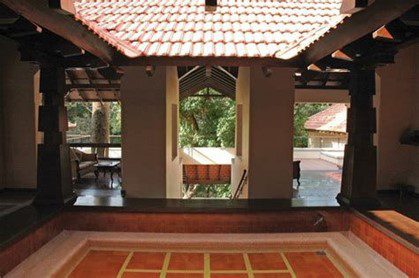
(Source: Pinterest)
Know more about registration department Kerala and online property services
Traditional Kerala house design: Pillars
The roof frame in traditional Kerala houses is structurally supported on the pillars on walls erected on a plinth raised from the ground for protection against dampness and insects in the Kerala monsoon. The pillars in the house instead of walls, were a common factor in Kerala’s old house interior design. The pillars were placed on the sitting area on the front porch of traditional Kerala houses. These traditional columns added aesthetic appeal too, as they often had delicate carving.

Source: Pinterest
Traditional Kerala house design: Charupadi (veranda seating)
Traditional houses in Kerala have charupadi, a built-in wooden seat in an extended porch or balcony, called the poomukhom, facing the entrance. This veranda allows one to relax and enjoy the views around the home, the breeze, and the rain. Traditionally, these were made for the family and visitors to sit and socialise.

Source: Pinterest
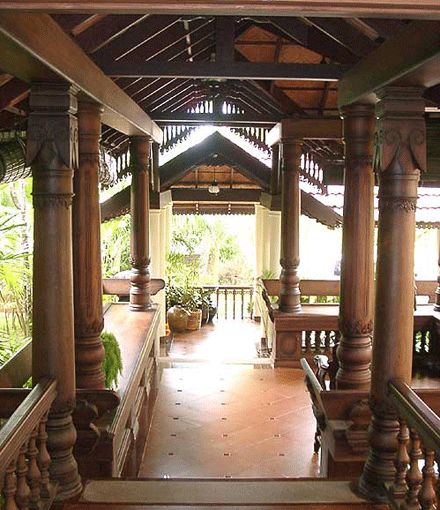
(Source: Pinterest)
Traditional Kerala house design: Ambal kulam (pond)
Designs of traditional houses in Kerala ensured that homeowners never were away from nature. As per Vastu, water bodies balance the energies of the house. According to Kerala architecture, every traditional house has a pond situated at the end of the chuttu veranda, an open passage. Traditionally, this pond was built with rubble and was used for bathing. The pond also helped the family to unwind and relax in the evening. Today, these ponds add to the beauty of the house with lotus and lilies.

See also: All about the different types of houses in India
Traditional Kerala house design: Interiors
Traditional houses in Kerala are known for their sturdy wooden furniture and intricate wooden carvings. Even today, traditional handicrafts of Kerala like wooden seating with fewer cushions, oversized chairs, four-poster beds, and recliners made of wood in the dark polish, are popular all over the world. Homes may also have teak or rosewood swings – oonjal – in the veranda or the centre of the living room. The walls are decorated with ethnic art and antiques made from teak, sandalwood and mahogany. Decorative brass items like nettur petti (traditional jewellery box), earthen pots, and dark-toned metal items adorn traditional houses.
In traditional Kerala houses, metal objects were largely seen in home decor. Bell metal crafts products are known for their centuries-old craftsmanship and heritage. This metal is a mix of tin and copper. Decor items, religious artefacts and sculptures are made even today with this age-old crafting technique. Traditional metalwork of Kerala like hanging bells, brass lamps (nilavilakku), and idols of Lord Ganesha, Goddess Lakshmi, Nandi bull, and elephant also decorate the interiors. Ornamental brass locks called manichitrathazhu adorn the double-door entrance. Kerala’s mural art made with natural pigments is a significant feature in Kerala homes and portrays stories from Indian mythology. Even traditional coir crafts of Kerala were a part of home décor – doormats, floor mats, wall panelling, mattresses, baskets, etc., were all made of coir.


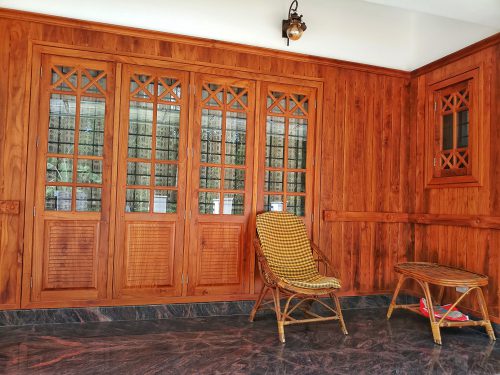

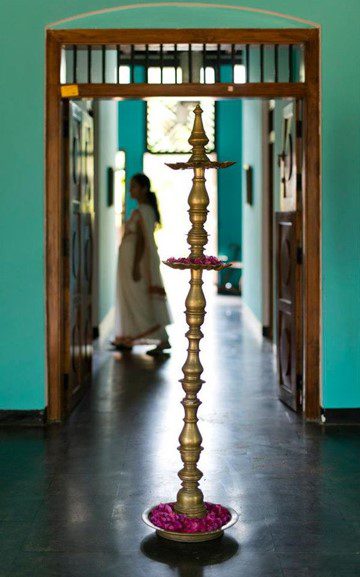
(Source: Pinterest)

Source: Pinterest

Source: Pinterest

Source: Pinterest
Traditional Kerala house design: Furniture
In the traditional homes of Kerala, wooden furniture was widely used. Kerala is well known for its elaborately designed wooden furniture, which showcases its rich cultural heritage. The uniqueness of Kerala’s wooden furniture lies in its intricate craftsmanship. Kerala woods, such as teakwood and rosewood, are known for their strength, durability, comfort and aesthetics. The wood carving process was handmade and carried out with the use of traditional carpenters’ tools. The durable furniture made in Kerala is usually passed on to the next generations. Skilfully crafted doors, with symbols of deities, Rocking chairs, diwan, carved cabinet sofas and floor rested wooden temples, are even now in demand, in modern homes.

Source: Pinterest

Source: Pinterest

Source: Pinterest
Traditional Kerala house design: Layout
Modern houses in Kerala have incorporated many features of the traditional Kerala homes, especially open architecture and spacious floor plans, and nalukettu style of architecture like the sloping roof, a small veranda supported by tall pillars, and a mini courtyard in the middle. Besides homes, the traditional house design has also inspired hotels, restaurants and spas. The contemporary house designs modify certain features as per the modern lifestyle. Traditional elements such as wooden furniture, pillars and courtyards are part of modern houses in an evolved structural design.

(Source: Pinterest)
Check out the living room of this Kerala style contemporary house design.
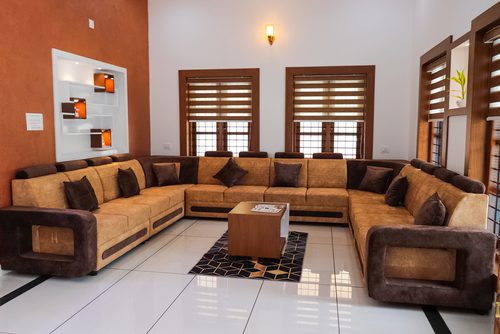
(Source: Pinterest)
Check this four-bedroom Kerala style contemporary house design. The two-storey structure includes family and guest living areas, two bedrooms, kitchen and work areas in the ground floor. In the upper floor, there is a living area, two bedrooms and balcony.

See also : know all about Sanketham building permit in Kerala
Traditional Kerala house design: Advantages
There are many advantages of traditional Kerala architecture. Natural and local materials are used that improve durability and encourage a higher level of detail and craftsmanship. These are also more cost-effective. Local materials such as laterite stone, wood, clay, bamboo, and granite are some of the locally available materials that are easily accessible and sustainable. Traditional Kerala houses use granite slabs below the ground to avoid dampness. Thatch and clay tiles on the sloped roofs help keep the house dry. Traditional houses of Kerala are energy efficient and are built in harmony with their natural surroundings. For maximum natural light and air passage, courtyards, walls and internal partitions are designed to induce continuous air movement and cross-ventilation.
Traditional Kerala house design: Photos
Check these photos of beautiful traditional Kerala-style houses.





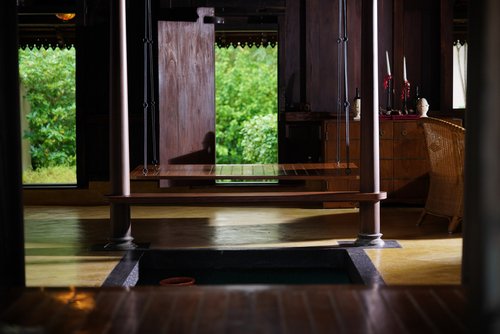

FAQs
What are the other names of traditional houses of Kerala besides nalukettu?
The nalukettu houses are also referred to as tharavadu, kovilakam, kotare, meda or illam.
What was the flooring made of in traditional houses of Kerala?
Red-oxide flooring is known to have been part of many houses This flooring is also known as kaaviyidal. Clay tiles and wooden flooring were also common in traditional houses.
Which wood has been used in traditional houses of Kerala?
Teakwood and wood of jackfruit tree were used for the construction of the doors and windows.
What is Tulsi Thara in the traditional house of Kerala?
Tulsi Thara is a stone platform in front of traditional Kerala houses where the holy basil (tulsi) is planted.
What sets apart Kerala house design?
Kerala house design is celebrated for its unique fusion of tradition and innovation, showcasing distinctive features like sloping roofs, intricate woodwork, and cross-ventilation. Specifically tailored for Kerala's climate, these designs incorporate open courtyards, expansive windows, and verandas, promoting natural light and airflow for a healthier living space. Notably, Kerala house designs prioritize sustainability by using locally sourced materials and traditional construction methods, aligning with eco-friendly practices to reduce the environmental impact.
How does Kerala house design evolve for modern living?
While deeply rooted in tradition, Kerala house designs seamlessly adapt to contemporary needs. They strike a balance by incorporating modern amenities like modular kitchens, updated bathrooms, and technological integrations while preserving the core elements that define the style. Emphasizing functional layouts and communal spaces, these designs foster a sense of togetherness, catering to the evolving preferences of modern lifestyles.
What is the cultural significance of Kerala house design?
Kerala house design holds profound cultural significance, serving as an embodiment of the state's architectural heritage. The intricate carvings, vibrant colors, and craftsmanship reflect Kerala's rich cultural legacy, transcending beyond mere structures to become expressions of tradition, history, and artistry. By embracing and preserving Kerala house designs, communities uphold their cultural identity, showcasing a harmonious blend of tradition and modernity that speaks to Kerala's adaptability and the enduring value of its architectural heritage.
| Got any questions or point of view on our article? We would love to hear from you. Write to our Editor-in-Chief Jhumur Ghosh at [email protected] |

Dhwani is a content management expert with over five years of professional experience. She has authored articles spanning diverse domains, including real estate, finance, business, health, taxation, education and more. Holding a Bachelor’s degree in Journalism and Mass Communication, Dhwani’s interests encompass reading and travelling. She is dedicated to staying updated on the latest real estate advancements in India.
Email: [email protected]
